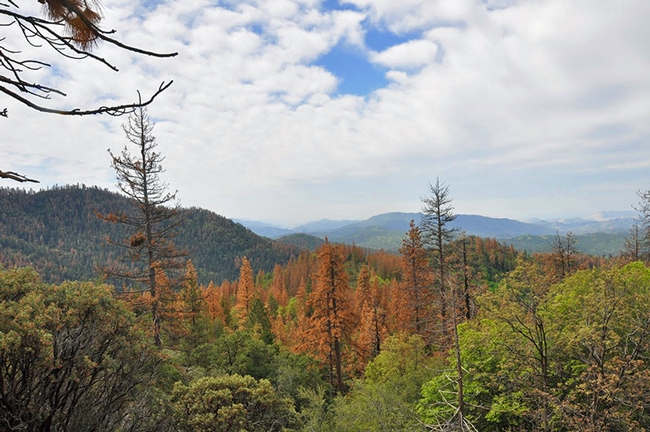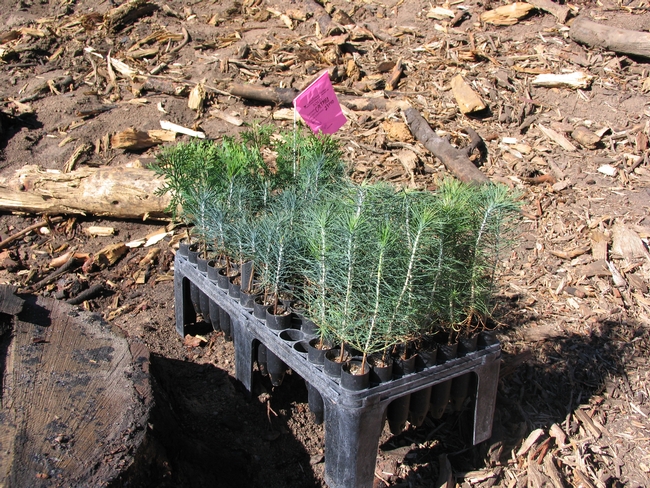Reposted from the UCANR Green Blog
This winter, a generous amount of rain and snow has fallen on California, but it can't erase the brown swaths of dead and dying trees in the Sierra Nevada caused by five years of drought and decades of forest mismanagement.
Fire suppression and the harvest of the largest and most resilient trees in the forest led to a large population of weak trees. The prolonged drought further weakened the trees' defenses against native insects. Aerial detection surveys show that more than 102 million trees have died since 2010; more than 62 million died in 2016 alone. Public and private landowners are now struggling to recover from this natural disaster.
UC Cooperative Extension forester and natural resources advisor Susie Kocher recommends dead trees be removed and the landscape reevaluated.
“The dead trees will eventually fall,” Kocher said. “Removing trees around homes and other buildings is especially important for safety. Also, when they fall on the ground they become large fuels on the forest floor, leading to more intense fires.”
The cost of removing the trees can be substantial. The State of California is funneling disaster relief funds through California counties, utilities are felling trees that pose a threat to power lines, and local jurisdictions are removing trees that could fall on roads and other public infrastructure. However, most tree removal is the responsibility of private landowners.
When the dead trees are gone, before considering replanting, Kocher suggests Sierra residents carefully assess what has survived.
“There is often a lot of live vegetation remaining,” Kocher said. “Make a map and mark where you find living trees and shrubs and identify them by species and size. If you have a significant number of trees left, you may not need to replant.”
Kocher suggests nurturing the remaining young trees.
“You may want to thin trees out so that available sun and soil moisture are focused on the healthiest individuals. Some watering in the summer may help counter stress caused by increased solar radiation,” she said.
If removing the dead trees leaves the landscape too bare, replanting native conifers is a good strategy. Conifers include pine, cedar and fir trees, but in California's dense forests, firs and cedars – which do well in shady conditions – are beginning to dominate. Replanting may be a time to give native pines – such as Jeffrey, ponderosa and sugar pines – a chance to recover ground.
“The fact that many pines have died does not necessarily mean they are no longer adapted to your location, even with our warming climate,” Kocher said. “There may be a few locations that are less suitable for trees that have grown there in the past, but for most areas, local growing conditions should support native conifers in the near future.”
Native plants and shrubs that died during the drought or were damaged during tree removal will likely come back on their own without replanting. Shrubs and oaks can re-sprout and native herbaceous plants generally store seed in the soil that will grow under native rainfall conditions.
Replanting of trees also gives landowners the chance to shape the landscape for best effect. Kocher offers the following recommendations on replanting trees in natural landscapes:
- Space trees at least 10 feet apart.
- Trees and flammable vegetation should be kept at least 10 feet away from the home, planted sparsely within 30 feet of the home and spaced widely enough in the 30 to 100-food zone so the crowns of the trees will not touch when they are mature. Beyond 100 feet, trees can fill into a more natural looking forest.
- Plant trees at least 10 feet from power lines.
- Do not plant trees within the road right of way to prevent interference with snow clearance, maintenance and construction projects.
- Plant pines where there is a lot of sun. Do not plant sugar pine on the driest sites.
- Avoid planting where the mature trees will block desired views.

